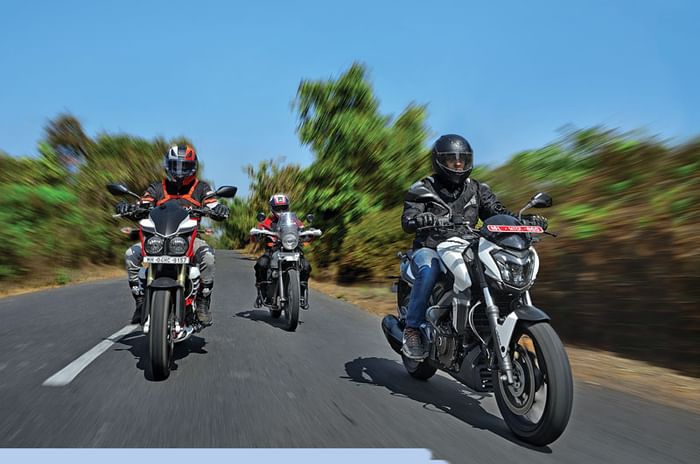Bajaj Dominar 400 vs Mojo vs Himalayan comparison
With touring on the menu, we delve into some highly debatable topics to find out which of these three bikes serves its purpose better, and which one is more deserving of your money.
Published on Feb 06, 2017 04:20:00 PM
46,257 Views
Follow us on



With the evolving demands of motorcyclists, manufacturers are pushed to make more versatile machines; something you can ride to the office and back, and has enough juice in its engine to make those weekends memorable, demands a certain amount of attention. And in the recent times, motorcyclists in India have begun to take more of a shine to touring this vast country. But with the number of tourers available, making that right choice could
be a bit confusing.
No motorcycle is bad in its entirety. Each motorcycle has its own identity, characteristics that make it unique and fun to ride once you figure out the techniques needed to harness its full potential. That isn’t to say that they don’t have their shortcomings. With the recently launched Bajaj Dominar 400 creating waves of excitement, we seek to find out if it really lives up to all the hype. Then, there’s the Royal Enfield Himalayan in one corner and the Mahindra Mojo in another; we pit the three motorcycles against each other in a showdown of design, versatility and value. After all, these motorcycles do hold the attention of the same category of buyers, riding-wise and budget-wise.
Under the blue sky
While the Dominar 400 and the Mojo are styled along the lines of new-age, naked sports-tourers, the Himalayan is clothed in adventure-tourer garb. Mahindra may admit that the Mojo is a tourer, but Bajaj has decided to call its motorcycle a power cruiser. When viewing the motorcycles alongside each other, the Dominar does appear to have the most compact dimensions. While the Mojo has a facade that could be called bulky and awkward, it does have a certain charm that some enthusiasts would really love. Let’s face it, it does look rather intimidating and could be mistaken for a larger motorcycle. The eyebrow-like LED strips above the headlights may make the Mojo appear like an angry owl, but it does look quite nice. The Dominar 400’s headlight setup, on the other hand, while still quite beefy, looks mature and proportional. And that mosaic-like LED headlight layout is fresh and appealing. The Himalayan simply towers over these two with its adventure-oriented styling. It displays a sort of raw, rugged charm. It has a purposeful, bare-bones stance that may not appeal to bikers who prefer smooth and flowy lines.
The Mojo’s instrument cluster consists of an analogue tachometer that lights up with the revs, and a digital readout for the speedometer and other information. It, however, feels hard to read under direct sunlight and is overly bright during night riding, which reduces a bit of vision in completely unlit situations. Bajaj has given the Dominar 400 a split console, with the handle-mounted one being all digital and quite easy to read, and the tank-mounted LED strip housing the warning lights. However, put on a full-face helmet and the tank strip is away from your field of vision. The Himalayan keeps things simple with its instrument cluster, but things do appear a bit cluttered. It gets an analogue speedo, tacho and fuel gauge, and a digital read-out for the odometer and trip meters. This is the only bike here to get a temperature gauge and gear indicator. It also gets a digital compass for when there isn’t a road in sight.
The tank on the Mahindra is angular and chunky, and it gets thick radiator shrouds on either side that complements the exposed twin-rib chassis. Bajaj’s fledgling, on the other hand, appears to have the better tank design compared to the Mahindra; it appears well-sculpted and mature. The Himalayan’s teardrop-shaped tank is designed to accommodate riding in the standing position to make off-roading easier.
Copyright (c) Autocar India. All rights reserved.



Comments
Member Login
Personal Details
No comments yet. Be the first to comment.